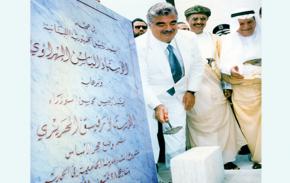إن اسهامات رفيق الحريري الخيرية والإنمائية لا تحصى، وأبرزها المساعدات المتعددة الأوجه لستة وثلاثين ألف طالب جامعي في جامعات لبنان وخارجه
أنت هنا
COMPARATIVE STUDY OF GLYCOPROTEINS OF FOUR POPULATIONS OF MELOIDOGYNE SPP. CULTURED ON DIFFERENT HOSTS
التبويبات الأساسية
Said K. IBRAHIM
|
Univ. |
Newcastle Upon Tyne |
Spec. |
Plant Nematology |
Deg. |
Year |
#Pages |
|
Ph.D. |
1990 |
192 |
The protein composition of Meloidogyne incognita (Bang), M. incognita (Agr), M. incognita (Leeds) and M. javanica was analyzed using different electrophoretic systems. More bands were resolved in both systems compared with the previous studies. Protein patterns of Meloidogyne spp. Reared on tomato, cucumber, and tobacco plants were indistinguishable. Protein profiles of extracts from females, isolated cuticles, second stage juveniles and eggs were dissimilar. More bands were detected from mature females.
Glycoprotein patterns were also analyzed by SDS‑gel electrophoresis, using Periodic acid Schiff's reagent ; a few bands with high molecular weights were detected. These glycoproteins are probably cuticular in origin . The glycoprotein profiles obtained from Meloidogyne spp. were almost identical when periodic acid Schiff's reagent was used.
The proteins were first resolved by polyacrylamide gel isoelectric focusing with a wide range of PH 3.5 ‑ 9.5 and were treated with I 125 labeled lectins . The degree to which these lectins bind was analyzed by autoradiography . 64 bands were deceted with Con A and 21 bands WGA lectins , and their isoelectric points ranged from 4.3 to 8.6 . This binding was reduced to some degree with the presence of specific sugars.
When nematodes were labeled with I 125‑labelled lectins and resolved with SDS‑polyacrylamide gel , fewer bands were detected . Con A stained up to 11 distinct bands , while WGA revealed 6 bands, and 4, 3, 2 , bands for PNA , PHA and nettle respectively . PNA , PHA and nettle showed weak binding . WGA failed to bind to the root‑tissue extracts . Quantitative data of I 125 labeled lectins to several developmental stages of M. incognita was also established . The highest specific binding was obtained with Con A and WGA, but less binding was observes with PNA , PHA , and nettle.
Protein extracts of females and cuticles of Meloidogyne spp. were fractionated on sodium dodecyl sulfate‑polyacrylamide gels, electrophoretically transferred to nitrocellulose sheet, and probed with 5 FITC‑lectins with different sugar specificity to detect glycoprotein patterns. Lectin binding was inhibited to a certain degree by the appropriate monosaccharides . Adult females , second stage juveniles , eggs and the jelatinous matrix of M. iavanica were examined using FITC‑labeled lectins . The results showed that the entire surface of the female cuticle bound strongly to Con A but to a lesser degree to the other lectins . A strong reaction was located on the head region especially on the amphidial and oesophegeal glands . Newly hatched J2 exhibited a lower affinity for Con A , WGA and VVA , while late J2 exhibited a higher affinity for Con A, lower affinity for WGA , TPA , PAA , and VVA , but negative staining with RCA , PLA , and LEA . Nematodes which had contact with the host gave strong fluorescence reactions . Quantitative measurements of different developmental stages were determined.
WGA bound specifically on the tip region of the head of the female but was absent or virtually absent from other areas of the head. Frozen sections of the females showed Con A lectin bound all over the section, whereas WGA, and VVA bound more specifically to certain areas of the nematode. Female extracts of M. Javanica analyzed by gas chromatography were determined. Over 18 peaks were obtained, and 6 peaks were identified. These results indicate the presence of a complex of carbohydrate glycoproteins containing mannose/ or glucose, N‑acetyl‑D‑glucosamine, D‑galactose, N‑acetyls‑D‑galactosamine and other sugars on the nematode organisms.










